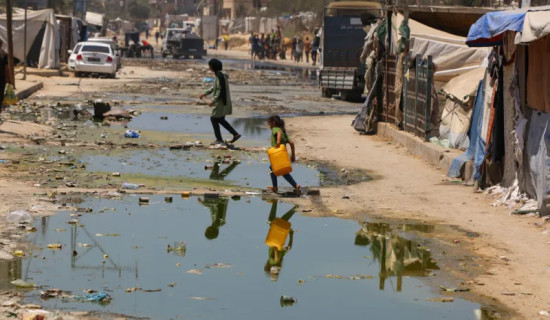- Wednesday, 24 July 2024
Data shows inland counties top disaster list
New York, July 24: Floyd County keeps flooding and the federal government keeps coming to the rescue.
In July 2022, at least 40 people died and 300 homes were damaged when the eastern Kentucky county flooded. It was the 13th time in 12 years that the rural county was declared a federal disaster. These are disasters so costly that local governments feel they can't pay for it all, so the governor asks the president to declare a disaster freeing up federal funds.
"After that flood I had 500 homeless people looking at me, 'Judge what are we going to do'?" recalled Judge Robbie Williams, administrator for the county of a bit more than 35,000 people. "It's overwhelming and it's just a matter of time before it happens again."
It did. In 2023, Floyd County was declared a disaster again for 14th time, starting in 2011. And Floyd County isn't even the nation's most disaster-prone county. Neighboring Johnson County has 15 disasters declared by the Federal Emergency Management Agency since 2011.
When it comes to extreme weather and other so-called natural disasters, people generally look to the hurricane or earthquake-prone coasts and say that's where the danger is. But that's not where the highest concentration of federally declared disasters are, according to an atlas of 713 FEMA declared disasters created by New York University's Institute for Public Knowledge. While most people in disasters think about federal government direct financial help to individual victims to pay for lost housing and businesses, the atlas focuses on the $60 billion pot of FEMA aid to governments.
Eight of the nine counties with the most federal declared disasters since 2011 — more than a dozen each — are in Kentucky, with the one in Vermont. These counties have four to five times the number of disaster as the national average of three in the past 13 years.
"California and Louisiana and I would say now even Texas, Florida, for sure, they soak up all the oxygen when you hear about these giant storms," said atlas creator Amy Chester, director of the disaster prevention-focused Rebuild By Design nonprofit group. "But what you're not hearing about are these storms that are happening all the time, and that's just becoming like, regular to places like Vermont." Chester also mentioned Tennessee, Oklahoma, Missisippi, Iowa and Alaska as hotspots.
"We want to show that climate change is already here," Chester said of the data covers 2011 to 2023, but doesn't include heat waves, drought or COVID. "Communities are suffering all over."
Before she crunched the data, Chester said she figured Vermont would be a haven from climate change. Cooler. Inland. Instead it's a disaster hot spot.
"It's awful" Chester said. "It just keeps happening to them."
Days after she said that Vermont flooded again, this time from the remnants of Hurricane Beryl.
Flooding is the most common disaster in the United States, according to FEMA. Since 2011, FEMA handed out more than $41 billion in aid following hurricanes, the most of any disaster type.
"What the data tell us is that the frequency and severity of disasters at local-state scales is increasing with rural, suburban, and urban places being affected nationwide," Susan Cutter, co-director of the Hazards Vulnerability and Resilience Institute at the University of South Carolina, said in an email. She wasn't part of Chester's research. "More needs to be done to enhance resilience to reduce their impacts on people."
The largest county in the nation that has not had a federally declared disaster since 2011 is Mecklenburg County, North Carolina, where the city of Charlotte is. (AP)









-original-thumb-original-thumb.jpg)





-original-thumb.jpg)

